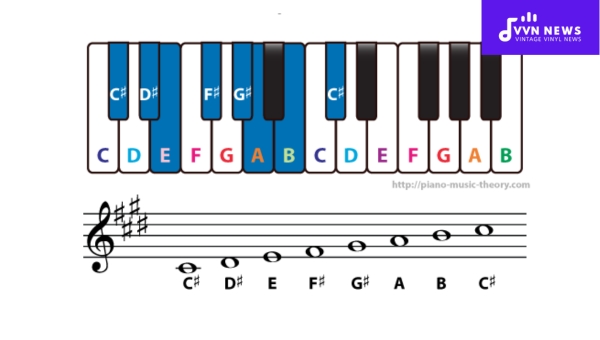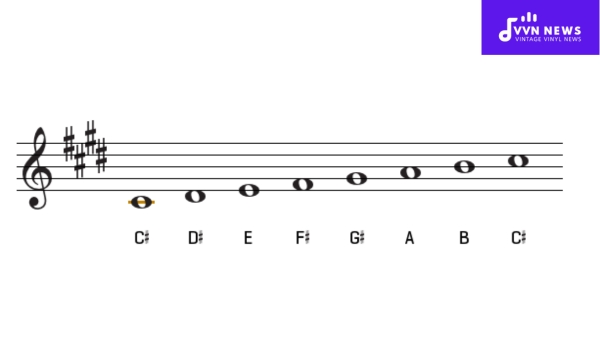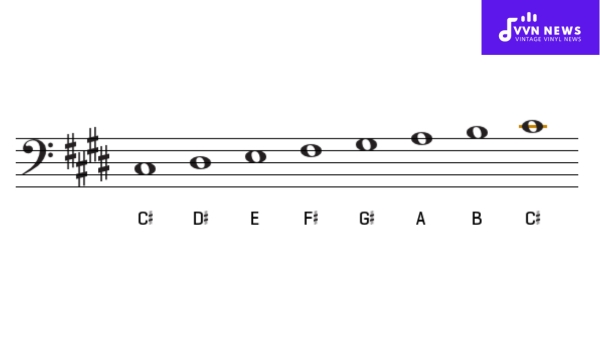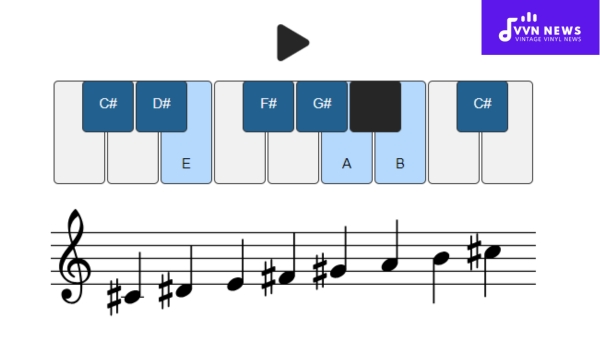Music, in its myriad forms, affords such an incredible scope for expression and creativity.
Within each note, each chord, and each scale lies a world of potential ready to be unlocked by keen musicians.
As we journey through this fascinating landscape of sound and rhythm today, let’s acquaint ourselves with one such component – the C sharp minor scale.
A significant element in music theory, the allure of the C sharp minor scale is undeniable.
As you delve into it, you’ll find that it lends a unique color and intensity to your musical piece.
Whether a novice dabbling with a few simple melodies on your keyboard or a seasoned professional contemplating your next symphony orchestra masterpiece, learning the C sharp minor scale will surely add another string to your bow of musical expertise.
What sequence of notes comprises the C Sharp Minor Scale?
Each scale in music theory is made up of several degrees, each representing a specific position.
The beauty of the C sharp minor scale lies in its intricate composition.
In simple terms, there are seven main degrees in this harmonic minor scale:
- Tonic – The first degree. This is undoubtedly C#
- Supertonic – The second degree, appropriately named D#
- Mediant – Found at the third degree of the scale. This would be E.
- Subdominant – Holding onto the fourth degree, we find F#.
- Dominant – The fifth degree proudly presents itself as G#.
- Submediant – Located at the sixth degree comes A.
- Leading note / Subtonic – Not one to miss out on the ‘sharp’ action, here we have B# firmly on our seventh degree.
Further complexities are added when considering melodic minor scales where ascending and descending arrangements are different.
Analyzing these degrees, it’s easy to get a grasp of how each note maintains its integral place within this rather fascinating key.
Embracing this detail will enable you to experiment with an assortment of harmonious combinations and unique compositions within your musical endeavors.
Demonstrate the C Sharp Minor Scale on piano and guitar?

On any musical instrument, the scale’s notes are fundamental in shaping the tune’s character. Now, let’s explore how you can play the C sharp minor scale on a piano and then switch gear to guitar.
Step-by-Step Guide to Play C Sharp Minor Scale on Piano
The notes comprising the natural ‘C sharp’ minor scale include: C#, D#, E, F#, G#, A, B. Here dotes ‘_#’ represent a sharp note.
- Begin with your thumb (1st finger) on the C# note.
- Proceed to play D# (2nd finger), and E (3rd finger).
- Bring your thumb under your hand to play F# (1st finger).
- Continue upwards with G# (2nd finger), A (3rd finger), B (4th Finger).
- To complete the octave, play next C# using your little finger i.e 5th Finger).
This is an octave in an ascending manner. You can repeat this succession of notes for descending the octave – simply follow these steps in reverse order.
Walking Through The C Sharp Minor Scale On Guitar
On a guitar too, we use similar concepts when orchestrating a melody but due to various positions and shapes of chords and scales makes guitar tad more complicated than piano.
Let’s see how we can construct a C sharp minor scale along one string:
- Start at the 9th fret on the low ‘E’ string – this is our root note, ‘C#’.
- Move up two frets to hit ‘D#’ at 11th,
- One fret up takes you to the ‘E’ note at 12th,
- Slide another two frets up for ‘F#’ located at the 14th,
- Two more up finds ‘G#’ at 16th,
- Yet another up takes you to ‘A’ at the 17th,
- Go two frets up for ‘B’ found at the 19th,
- Lastly, climb one more fret to complete the octave with another ‘C#’ at the 20th.
By taking this guide, you should now be able to play a C sharp minor scale on the piano and guitar. Give it a try and let these beautiful notes accompany your musical journey towards mastery and fun.
Also Read: A Minor Scale [Unlock The Mysteries Of Musical Composition]
How does the C Sharp Minor Scale display in various musical clefs?
As fascinating as unraveling the melodies in music is the ability to transcribe these into musical notations.
A crucial element in this, particularly for our target set of notes ‘the C sharp minor scale’, is learning how this scale appears across various musical clefs.
Treble Clef
Also known as the G clef, the treble clef flaunts the C sharp minor scale with an elegance that’s hard to miss.
This clef is predominantly used for high-register instruments and voices such as flute, violin, trumpet, or soprano vocals.
Herein, you’d see a set of five ledger lines with our scale running from an E on the bottom line up to another E on the top line.
Bass Clef
Contrary to its high-pitched counterpart, we have the bass clef portraying the lower register pitches generally rendered through instruments like tuba, double bass or even left-hand piano notes.
In this ‘F’ clef structure, your C sharp minor scale elegantly graces across from F at topmost line down to F at bottom line.
Alto and Tenor Clefs
Catering to mid-range pitches are your very versatile Alto and Tenor Clefs. While alto represents third line ‘C’, tenor places it on fourth line.
You’ll find viola musicians smitten by these keys while trombone and bassoon artists resort here occasionally too.
On all aforementioned clefs, remember your set of four sharps (F#, C#, G#, D#) accompanying every ‘natural’ (no-sharps/no-flats) note; signifying a splendidly harmonic C Sharp Minor Scale rendering.
Though specifics may seem overwhelming initially, believe me, their mastery offers innumerable rewards for those exploring the profound depths of music.
Ingraining them step-by-step etches a stronger intuitive connection between your piece and its depiction; making transcending between clefs seamless.
Which key signature is used for the C Sharp Minor Scale?

In music notation, the key signature for C sharp minor scale flagrantly presents itself with four sharps: F#, C#, G#, and D#.
These remarkable alterations occur in comparison to the natural minor scale, which is unaltered.
This key signature cleverly indicates which pitches to sharpen during play. Each time you come across these notes – F, C, G, and D – your instinct should be to ascend them by a half step.
Consequently, this tweak gives birth to the evocative tones that make the C sharp minor scale so compellingly distinctive.
Musical compositions bearing this characteristic key invite an audience into an atmosphere soaked in deeply intriguing emotions.
What major key is the counterpart to the C Sharp Minor Scale?
In the world of music, each minor key has a matching major key which shares the same key signature.
This major scale is known as the ‘relative major’ to its minor counterpart. For the C sharp minor scale, its relative major is E Major.
This link provides an interesting dynamic between these two scales, embodying different moods and flavors within the same bundle of notes.
These two scales express an entirely different essence despite their common ingredients.
The shift between major and minor can certainly add depth to your music, all within the confines of same notes.
Also Read: G Minor Scale [Guide To Understanding This Melancholic Tune]
What are the key chords of the C Sharp Minor Scale?

The C# minor scale primarily consists of seven chords. These are the major, minor, and diminished chords which are fundamental to creating melodies within this scale.
Below is a list of these primary chords and their characteristics:
- C# minor (i): This is the tonic chord of the scale, formed from the root (C#), minor third (E), and perfect fifth (G#).
- D# diminished (ii°): Formed by D#, F#, A.
- E major (III): Root note E, accompanied by G# and B.
- F# minor (iv): Consists of F#, A, C#.
- G# minor (v): Formed with notes G#, B, and D#.
- A Major (VI): Features notes A, C#, E.
- B Major (VII): B, D#, F#.
Weaving these chords into various combinations can create rich harmonic progressions that captivate your audience in ways only known to the beauty that’s inherent in C Sharp Minor Scale.
Also Read: C Minor Scale [How To Master This Powerful Chord Progression]
FAQs About The C Sharp Minor Scale
What is the sequence of notes for the C Sharp Minor Scale?
The C Sharp Minor Scale is comprised of the following notes in sequence: C#, D#, E, F#, G#, A, and B.
How do you identify a piece in the C Sharp Minor key?
Pieces in C Sharp Minor often start and end on the note of C Sharp as it’s significant to this scale.
What is the relative major key of the C Sharp Minor Scale?
The relative major key to C sharp minor is E major.
Why do certain musical pieces incorporate the C Sharp Minor Scale?
The C sharp minor scale adds a particular touch of melancholy and emotional intensity, hence it is favored in many dramatic compositions.
Can you play different styles of music with the C Sharp Minor Scale?
Absolutely! The use of any scale, including the C Sharp Minor, crosses over all music genres and styles – from classical to rock, blues to jazz.
Conclusion
Mastering the C sharp minor scale can greatly enhance your proficiency and versatility as a musician.
Whether you are composing, improvising or analyzing music, this scale offers a spectrum of expressive options.
Experiment with different combinations of notes, chords and progressions to uncover its full potential.
It might appear challenging initially, but with regular practice and commitment, the C sharp minor scale will soon become an integral part of your musical toolkit.








